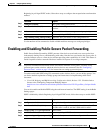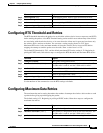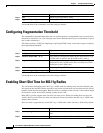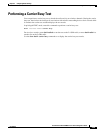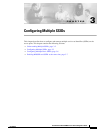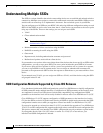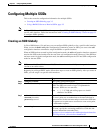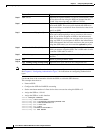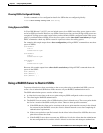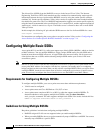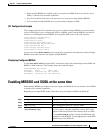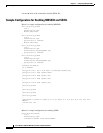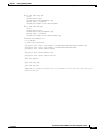
3-3
Cisco Wireless ISR and HWIC Access Point Configuration Guide
OL-6415-04
Chapter 3 Configuring Multiple SSIDs
Configuring Multiple SSIDs
Configuring Multiple SSIDs
This section contains configuration information for multiple SSIDs:
• Creating an SSID Globally, page 3-3
• Using a RADIUS Server to Restrict SSIDs, page 3-5
Note In Cisco IOS Release 12.4(15)T and later, you configure SSIDs globally and then apply them to a
specific radio interface. Follow the instructions in the
“Creating an SSID Globally” section on page 3-3
to configure SSIDs globally.
Creating an SSID Globally
In Cisco IOS Releases 12.4 and later, you can configure SSIDs globally or for a specific radio interface.
When you use the dot11 ssid global configuration command to create an SSID, you can use the ssid
configuration interface command to assign the SSID to a specific interface.
When an SSID has been created in global configuration mode, the ssid configuration interface command
attaches the SSID to the interface but does not enter ssid configuration mode. However, if the SSID has
not been created in global configuration mode, the ssid command puts the CLI into SSID configuration
mode for the new SSID.
Note SSIDs created in Cisco IOS Releases 12.3(7)JA and later become invalid if you downgrade the software
version to an earlier release.
Beginning in privileged EXEC mode, follow these steps to create an SSID globally. After you create an
SSID, you can assign it to specific radio interfaces.
Command Purpose
Step 1
configure terminal Enter global configuration mode.
Step 2
dot11 ssid ssid-string Create an SSID and enter SSID configuration mode for the new
SSID. The SSID can consist of up to 32 alphanumeric
characters. SSIDs are case sensitive.
Note +, ., ], ?, $, TAB, and trailing spaces are invalid
characters for SSIDs.
Step 3
authentication client
username username
password password
(Optional) Set an authentication username and password that
the access point uses to authenticate to the network when in
repeater mode. Set the username and password on the SSID that
the repeater access point uses to associate to a root access point,
or with another repeater.
Step 4
accounting list-name (Optional) Enable RADIUS accounting for this SSID. For
list-name, specify the accounting method list. Click this link
for more information on method lists:
http://www.cisco.com/univercd/cc/td/doc/product/software/ios
122/122cgcr/fsecur_c/fsaaa/scfacct.htm#xtocid2



